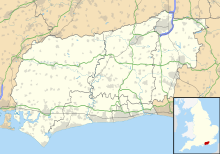| Site of Special Scientific Interest | |
 | |
| Location | West Sussex |
|---|---|
| Grid reference | TQ 250 112[1] |
| Coordinates | 50°53′13″N 0°13′26″W / 50.887°N 0.224°W |
| Interest | Biological Geological |
| Area | 321.0 ha (793 acres)[1] |
| Notification | 1986[1] |
Beeding Hill to Newtimber Hill is a 321 ha (790-acre) biological and geological Downland Site of Special Scientific Interest (SSSI) north of Shoreham-by-Sea in West Sussex.[1][2] It is a Nature Conservation Review site, Grade 2,[3] and it includes Devil's Dyke Geological Conservation Review site.[4][5]
There are thirteen distinct areas within this SSSI. Most of it is on the north-facing slope of the South Downs on unimproved chalk grassland. Grazed chalk downland, such as this, has a diverse flora with around 40 flowering plants per square metre.[6] There are areas of scrub and in places this scrub has developed into woodland, and there are also some areas of mature beech woodland.
The richest areas are dominated by upright brome and fine-leaved grasses such as sheep's fescue and crested hair-grass. The site supports rare orchid species including frog orchid and in the woodlands, yellow bird's nest and bird's nest orchid. The site supports a nationally important assemblage of the Opilionid group of Arachnids (harvestmen), a locality of the nationally uncommon scarce forester moth and the adonis blue butterfly.[7]
- ^ a b c d "Designated Sites View: Beeding Hill to Newtimber Hill". Sites of Special Scientific Interest. Natural England. Retrieved 18 April 2019.
- ^ "Map of Beeding Hill to Newtimber Hill". Sites of Special Scientific Interest. Natural England. Retrieved 18 April 2019.
- ^ Ratcliffe, Derek, ed. (1977). A Nature Conservation Review. Vol. 2. Cambridge, UK: Cambridge University Press. p. 120. ISBN 0521-21403-3.
- ^ "Devil's Dyke (Quaternary of South-East England)". Geological Conservation Review. Joint Nature Conservation Committee. Retrieved 5 April 2019.
- ^ "Devil's Dyke (Karst)". Geological Conservation Review. Joint Nature Conservation Committee. Retrieved 5 April 2019.
- ^ "What's special about chalk grassland?". National Trust. Retrieved 10 November 2021.
- ^ Cite error: The named reference
:1was invoked but never defined (see the help page).
